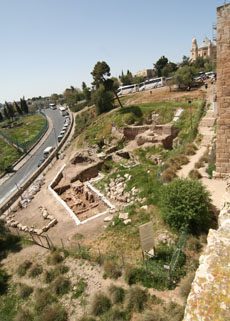James Tabor Leads a Five-year Archaeological Dig in Jerusalem


It wasn’t a typical summer break for UNC Charlotte professors James Tabor and Shimon Gibson. Tabor, religious studies department chair, and Gibson, an archaeologist and adjunct religious studies professor, led nearly 50 students, alumni and other volunteers in an archaeological dig in Jerusalem in June and July 2009. During the second year of their excavation at Jerusalem’s Mount Zion, the dig team unearthed an extremely rare 2,000-year-old limestone cup inscribed with 10 lines of Aramaic or Hebrew script.
The inscription dates from the first century A.D. and is being deciphered by a team of epigraphic experts to determine the meaning of the text, which is clear but cryptic. The ritual cup is made that much more newsworthy due to the inscription’s mysterious nature, says Tabor. He figures it has been purposefully encoded, which adds a new level of intrigue to the purpose and meaning of the vessel.
The dig also produced a sequence of building remains dating from the first century A.D. through the Byzantine (fourth century A.D.) and Early Islamic (sixth century A.D.) periods. One interesting find was a house complex with a mikveh, or purification pool, with a remarkably well-preserved vaulted ceiling. Inside the house, the dig team found three bread ovens that dated to the year 70 A.D.
Ten murex shells were also found on the site. These shells are believed to have been used for the dye that priests used to color their sacred vestments at that time. This further proves that the dig site was once the priestly quarter of Jerusalem, according to Tabor. In addition, a large, arched building with a mosaic floor from the Byzantine period was uncovered.
UNC Charlotte is the only U.S. university that has been given a license to dig in Jerusalem in over 20 years. The dig, co-sponsored by the religious studies department and the anthropology department, is a five-year project. Tabor hopes to complete the digging by 2012, and the team’s goal is to start developing an archaeological park in 2013, depending on funding. The park, which will be called “A Journey through Time,” will highlight the diverse and complex cultural history of the area – covering Muslim, Jewish and Christian history.
“We’re committed to preserving all levels of culture,” says Tabor. “Unlike other archaeological digs, we’re purposefully leaving the site intact, so visitors to the park will be able to explore the full range of history of this multicultural area.”
Religious studies graduate student Melissa Fleischer won a competitive $1000 scholarship from the journal Biblical Archeology Review to participate in this summer’s dig. Fleischer says her experience on the dig in Jerusalem was a once-in-a-lifetime opportunity.
“I had always dreamed of having the opportunity to dig in the Holy Land,” says Fleischer. “The opportunity to learn from the best during the Mount Zion excavations will facilitate my graduate studies and help me narrow my research interests.”
Students can participate in the dig for either two- or four-week periods, with a two-week commitment equaling a three-hour course credit. Tabor points out that students don’t have to specialize in religious studies or archaeology to benefit from the experience at Mount Zion.
Tabor says the most rewarding aspect of the dig experience for students may be the exposure to the incredible diversity of Jerusalem.
“They are observing and experiencing first hand the complexity of the Middle East,” says Tabor. “Every day, students will see orthodox Jews walking with Muslims and Christians. Jerusalem is just this huge panoply of everybody mixed together, and that can be an eye-opening experience.”
For more information about the Mount Zion excavation, go to www.digmountzion.com. The dig and the development of the park rely on gifts from individuals and organizations. For more information about contributing, contact Sharon Harrington at scharrin@uncc.edu or 704-687-0082.